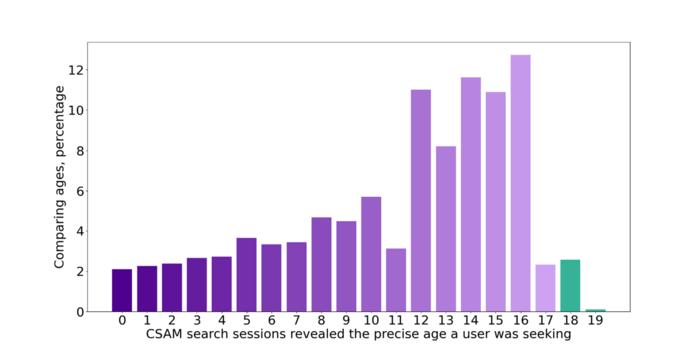The Onion Router (Tor) encrypts the origin of communications to avoid surveillance, ensure uncensored internet browsing and enable the creation and maintenance of anonymous and untraceable onion websites. An international team of researchers has completed the first large-scale study of Tor users to discover what exactly they are looking for and how widely CSAM material is available through the Tor network. The researchers also conducted an intercept survey to directly engage Tor users.

Credit: Juha Nurmi, Tampere University
The Onion Router (Tor) encrypts the origin of communications to avoid surveillance, ensure uncensored internet browsing and enable the creation and maintenance of anonymous and untraceable onion websites. An international team of researchers has completed the first large-scale study of Tor users to discover what exactly they are looking for and how widely CSAM material is available through the Tor network. The researchers also conducted an intercept survey to directly engage Tor users.
The study, led by Tampere University, looked at 176,683 onion domains operating through the Tor network between 2018 and 2023. The researchers found that in 2023 alone, one in five of these websites shared child sexual abuse material. This material was easily available on 21 of Tor’s 26 most popular search engines, four of which even advertised CSAM on their landing page.
The article titled “Investigating child sexual abuse material availability, searches, and users on the anonymous Tor network for a public health intervention strategy” appeared in Scientific Reports on 3 April 2024.
A Tor search engine tracked the search behaviour
Juha Nurmi, a researcher at Tampere University’s Network and Information Security Group (NISEC), led the research and analysed the content available on onion websites and the search behaviour of Tor users. He was also the lead author of the research paper.
A decade ago, Nurmi developed Ahmia.fi to serve as a search engine for the Tor network.
“I programmed the search engine to automatically filter the search results for child sexual abuse material and redirect users seeking such content to self-help websites. Despite these measures, a significant percentage of users are still trying to find illegal content through my search engine,” he says.
The researchers analysed 110,133,715 search sessions in the Ahmia search engine and found that 11% of these clearly sought CSAM.
“One of the most popular searches is ‘child porn’. A closer review of sexual material searches, in which 479,555 searches revealed the age directly sought, showed that, for example, 40% of searches targeted 11-year-olds or younger and 54% targeted 12–16-year-olds,” says Juha Nurmi.
Researchers provided links to self-help services for CSAM users
One of the starting points of the study was to find ways to address illegal and harmful behaviour on the Tor network. Besides staging an intervention, the study sought to provide assistance to users. In the study, the search engine identified searches for CSAM and directed users to answer a survey. Simply answering the survey takes 15-20 minutes and already constitutes an intervention. Over the course of more than a year, users completed the survey a total of 11,470 times.
The findings reveal that 65% of the survey respondents were first exposed to CSAM when they were children themselves. Half of the respondents first came across CSAM accidentally, indicating that the material is easily available online. 48% of users said they want to stop viewing CSAM. Some of them have sought help through the Tor network, and self-care guides are popular.
“Our research found links between viewing violent material and addiction. Seeking help correlates with the duration and frequency of viewing as well as with an increase in depression, anxiety, thoughts of self-harm, guilt and shame. While some have sought help, 74% of them have not received it,” Nurmi says.
In the study, the direct interference with the search for CSAM caused users to respond to the survey and confirmed the need for assistance. Recent studies in clinical psychiatry show that online therapies, such as the Bridge Project, effectively help people who are sexually attracted to children and view CSAM – as long as abusers are motivated to change.
Researchers from different fields
The study brought together expertise from information security, computer science, criminology, psychology and society. Peer reviewers particularly noted how well the paper filled in research gaps, improved methods and combined the data into a useful whole.
The multidisciplinary study involved researchers from Finland, Spain and the United States. Mikko Aaltonen, professor of criminology at the University of Eastern Finland, conducted the statistical analysis of the survey. David Arroyo of the Spanish National Research Council and Billy Bob Brumley, a professor at the Rochester Institute of Technology in the United States, contributed to the technical research and writing of the article. In addition, Tegan Insoll, Anna K. Ovaska, Valeriia Soloveva and Nina Vaaranen-Valkonen from the Protect Children organisation helped to design the research from the perspective of psychotherapy and legislative development and analysed survey responses.
Juha Nurmi, Arttu Paju, Billy Bob Brumley, Tegan Insoll, Anna K. Ovaska, Valeriia Soloveva, Nina Vaaranen-Valkonen, Mikko Aaltonen, and David Arroyo “Investigating child sexual abuse material availability, searches, and users on the anonymous Tor network for a public health intervention strategy” Scientific Reports, 2024.
Journal
Scientific Reports
Subject of Research
People
Article Title
Investigating child sexual abuse material availability, searches, and users on the anonymous Tor network for a public health intervention strategy
Article Publication Date
3-Apr-2024



